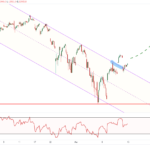Friday’s trade (in GMT terms) saw USD/CAD within the range of 1.3353-1.3434. The pair closed at 1.3397, inching up 0.08% compared to Thursdays close. It has been the 194th gain in the past 370 trading days and also a fourth consecutive one. The daily high has been a level not seen since March 9th, when a high of 1.3448 was registered. In weekly terms, USD/CAD added 0.44% to its value during the past week. It has been the 17th gain in the past 43 weeks, a second consecutive one, but yet, the smallest one since the week ended on September 11th. The major pair has extended its advance to 2.05% so far during the current month, following a 0.18% gain in September.
At 9:34 GMT today USD/CAD was inching down 0.05% on the day to trade at 1.3390. The pair touched a daily high at 1.3429 during early Asian trade, overshooting the range resistance level (R3), and a daily low at 1.3375 during the early phase of the European trading session.
On Monday USD/CAD trading may be influenced by the following macroeconomic reports as listed below.
Fundamentals
United States
Personal Income, Personal Spending and PCE Inflation
Personal spending in the United States probably grew 0.4% in September, according to market expectations, while personal income was probably up for an 18th consecutive month in September, increasing at a monthly rate of 0.4%.
Consumer spending, which accounts for over two thirds of the nation’s GDP, remained unchanged in August from a month ago, following a revised up 0.4% gain in July. August’s performance came as a result of lower spending on durable and non-durable goods, while spending on services went up.
At the same time, personal income increased 0.2% in August, decelerating from a 0.4% surge in the prior month. August’s increase has been the smallest since February, as wages and salaries grew 0.1%, after rising 0.5% in July.
Higher-than-expected rates of increase imply good employment conditions and, therefore, are dollar positive. The Bureau of Economic Analysis is to publish the official figures at 12:30 GMT.
At the same time, the Core PCE Price Index, the preferred measure of inflation by the Federal Reserve, probably rose 1.6% year-on-year in September, according to expectations. Annualized PCE inflation was at 1.7% in August, or the highest since February. On a monthly basis, the Core PCE Price Index probably increased for a ninth consecutive month in September, going up 0.1%, according to analyst projections.
Chicago manufacturing activity barometer
The Chicago Purchasing Managers’ Index (PMI) probably decelerated to a reading of 54.0 in October, according to market expectations, from 54.2 during the prior month. If so, October would be the fifth consecutive month of activity expansion in the region. In September, the gauge of production rose sharply to its highest level since January 2016, while the sub-indexes of new orders and order backlogs remained little changed. The sub-gauge of employment, on the other hand, dropped during the same month.
The index reflects business conditions in Chicago’s manufacturing sector and is interrelated with the Manufacturing Index, published by the Institute for Supply Management (ISM). A reading above the key level of 50.0 is indicative of optimism (expansion in manufacturing activity). In case the PMI slowed down more than forecast, this would have a moderate bearish effect on the US dollar. The ISM-Chicago Inc. will release the official reading of this barometer at 13:45 GMT.
Canada
Producer Prices
Prices of industrial products in Canada probably edged up at a monthly rate of 0.2% in September, according to market expectations. In August, prices unexpectedly dropped 0.5%, which has marked the first decrease in four months. In annual terms, prices went down 1.3% in August to mark a seventh consecutive period of decline.
This index measures the change in prices of industrial goods, sold by manufacturers in the country. It is also used as an indicator of commodity inflation. In case a larger-than-anticipated increase in prices is reported, this would have a limited bullish effect on the local dollar, as the latter tends to be sensitive to changes in commodity prices. Statistics Canada is to release the official data at 12:30 GMT.
Correlation with other Majors
Taking into account the business week ended on October 28th and the daily closing levels of the major currency pairs, we come to the following conclusions in regard to the strength of relationship:
USD/CAD to USD/JPY (0.6725, or strong)
USD/CAD to EUR/USD (0.6193, or strong)
USD/CAD to NZD/USD (0.1861, or weak)
USD/CAD to AUD/USD (-0.1064, or weak)
USD/CAD to USD/CHF (-0.4534, or moderate)
USD/CAD to GBP/USD (-0.4898, or moderate)
1. During the examined period USD/CAD moved strongly in one and the same direction with EUR/USD and USD/JPY.
2. The correlation between USD/CAD and NZD/USD, USD/CAD and AUD/USD was insignificant.
3. USD/CAD moved to a moderate extent in the opposite direction compared to USD/CHF and GBP/USD during the past week.
Bond Yield Spread
The yield on Canada’s 2-year government bonds went up as high as 0.591% on October 28th, or the highest level since October 19th (0.604%), after which it closed at 0.568% to lose 1.5 basis points (0.015 percentage point) compared to October 27th.
Meanwhile, the yield on US 2-year government bonds climbed as high as 0.900% on October 28th, or the highest level since June 2nd (0.911%), after which it fell to 0.857% at the close to lose 3.1 basis points (0.031 percentage point) compared to October 27th.
The spread between 2-year US and 2-year Canadian bond yields, which reflects the flow of funds in a short term, narrowed to 0.289% on October 28th from 0.305% on October 27th. The October 28th yield spread has been the lowest one since October 24th, when the difference was 0.282%.
Daily, Weekly and Monthly Pivot Levels
By employing the Camarilla calculation method, the daily levels of importance for USD/CAD are presented as follows:
R1 – 1.3404
R2 – 1.3412
R3 (Range Resistance – Sell) – 1.3419
R4 (Long Breakout) – 1.3442
R5 (Breakout Target 1) – 1.3468
R6 (Breakout Target 2) – 1.3478
S1 – 1.3390
S2 – 1.3382
S3 (Range Support – Buy) – 1.3375
S4 (Short Breakout) – 1.3352
S5 (Breakout Target 1) – 1.3326
S6 (Breakout Target 2) – 1.3316
By using the traditional method of calculation, the weekly levels of importance for USD/CAD are presented as follows:
Central Pivot Point – 1.3370
R1 – 1.3461
R2 – 1.3526
R3 – 1.3617
R4 – 1.3709
S1 – 1.3305
S2 – 1.3214
S3 – 1.3149
S4 – 1.3085
In monthly terms, for USD/CAD we have the following pivots:
Central Pivot Point – 1.3077
R1 – 1.3332
R2 – 1.3535
R3 – 1.3790
R4 – 1.4044
S1 – 1.2874
S2 – 1.2619
S3 – 1.2416
S4 – 1.2212





